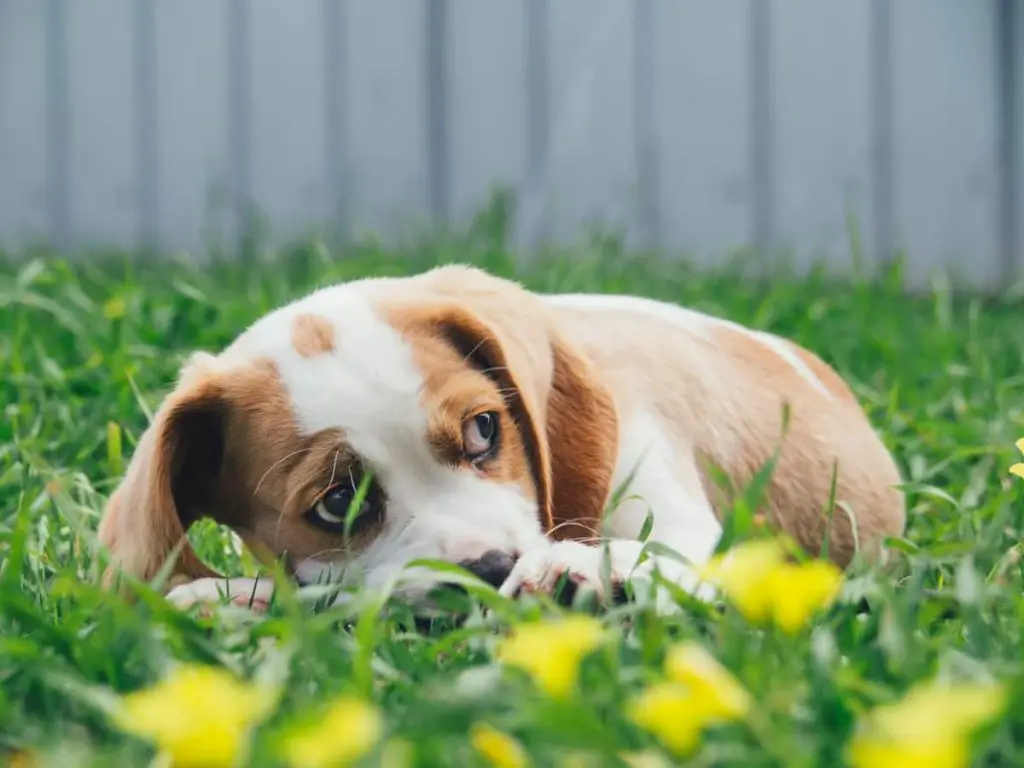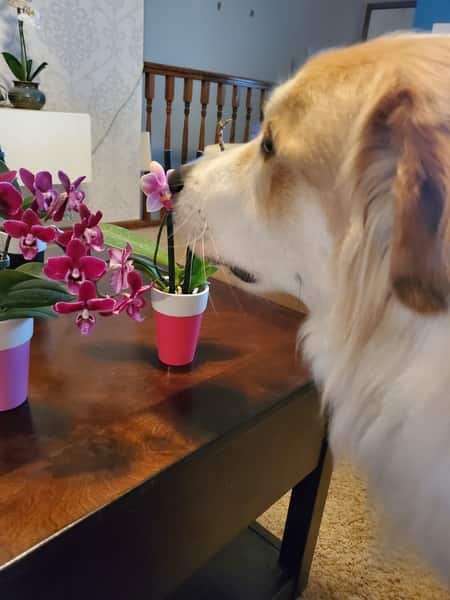Are Orchids Poisonous to Dogs?
Toxic Household Plants and Side Effects
Dogs are famous for chewing: slippers, coffee table legs, shoes, and yes, even plants. Once in a while, Max will be found with something he shouldn’t have in his mouth. Households plants are no exception. What happens to a dog when he ingests an orchid? Are orchids poisonous to dogs? Are they toxic?
Orchids are not poisonous to dogs, cats, or other household pets. The harm can come from pesticides, fertilizers, tinted dye, and redwood bark in the potting medium.
Pesticides and orchid fertilizers pose threats to the dog’s stomach lining when ingested because of the harsh chemicals. Redwood bark can cause irritations in the dog’s lungs and nose. The tinted blue and green dye is said to be harmless but most companies do not provide a list of the chemicals that are used. In this article, I’ll go over each one of these and explain where the harm is found for your dog. Before I start, you will hear lots of fabulous stories about the effects of eating orchids, but most lack proof. Some orchids, like Oncydium cellobata, were believed to be toxic but after research, that was proved to be a myth. Others are said to have psychedelic properties, but that was also proved a lie. All orchids are edible, and if you want a recipe, you might like to read this article I wrote.
What can be poisonous to your dog when he chews on orchids comes from the fertilizers and pesticides you might use, and not the orchid itself. There are some potting mixes that contain an overdose of chemical fertilizers, so be alert if your dog presents signs of fever, panting, hunched back, vomiting, or diarrhea.
If these signs are present, urgently take your pet to the vet.
• Panting
• Vomiting
• Diarrhea
• Agitation
• Tremors
• Excessive drooling
TOXIC ORCHID MYTH
To understand this in more depth, let’s analyze at what could potentially harm dogs. First of all, not poisonous does not mean “free of all harm.”
There are four levels of toxicity in household plants, which are divided into:
• MAJOR TOXICITY. When injected, these plants can cause serious illness which results in death. Thankfully, no orchids are listed here, but other houseplants are. If ingested, get your beloved pet to a vet asap.
• MINOR TOXICITY. These probably won’t include death, but vomiting and severe diarrhea are clear signs that your pet has eaten a minor toxic houseplant. No orchids were listed in this category, but again, many common houseplants were. Redwood bark, if ingested or inhaled, will cause these signs and symptoms. These serious side effects occur because the animal’s body senses the poison and feels the urgent need to eliminate it quickly. In this case, call your vet immediately and get some help over the phone.
• OXALATES. A common reaction to ingesting oxalates is what we could call a severe allergic reaction. Irritating the nose, skin, eyes, throat or other mucus membrane areas lead to a difficulty to breath. If the symptoms are austere enough, your pet’s throat could swell shut. If your vet doesn’t answer or is occupied, another place to call would be the poison control in your area. As for orchids, don’t be too concerned. No orchids are listed in this category either.
• DERMATITIS. This is the least serious of the four categories, yet the one we need to take a closer look at. When coming into contact with the toxic plant (juice, sap, or thorns) your skin can develop a rash or blister. One orchid was listed here, and I’ll explain more on that down below. (Source )
)
Most authors say that no orchids fall under any of these four categories, but in my research, I found one orchid that did. Taking into consideration that there are nearly 30,000 species, my research wasn’t extensive enough, to say the least. The good thing is that our concern is minimal; orchids reached the least concerning level.
Please note: this is not a consensus, since many authoritative sites insist on saying that NO orchids are “harmful.”
Our culprit: Cypripedium Reginae. This orchid is not considered to have oxalates, or be in the minor or major toxicity categories. But it is harmful, causing dermatitis. Although not death-striking or poisonous, the lady slipper orchid, or showy lady’s slipper, can cause skin irritation and a rash, very similar to poison ivy. Coming into contact with the hairs on the leaves that are more glandular in shape causes this reaction.
Interestingly enough, the native American tale of how the lady slipper got its name should cause some suspicion that the plant is dangerous.
Quick bask story into Ojibwe culture: an Indian tribe was being massacred due to health issues during a harsh winter. This plague was so devastating, it even killed the village healer. A brave young girl ventured out through the snow to find the cure amongst the mountains. On her way home, she lost her moccasins, leaving behind bloody footprints in the snow. In the spring, beautiful orchid sprung to life where she had left treacherous red marks. The Indians named this orchid the moccasin flower, which later was westernized to lady slipper. She did find the cure though, and saved her village. Inspiring, yet sad.
Back to dogs: since Max is obviously furry, none of the orchids wouldn’t be a concern unless he rubs his nose constantly around the Cypripedium Reginae orchid and makes it his personal habit of sniffing the flowers and stems. Still, it is not a poisonous orchid to your dog.
I would keep this orchid species away from small children and toddlers. Come to think about it, I’d keep all my orchids away from toddlers… Anyway, due to its natural habitat, this is not a common orchid that is sold on markets in modern times.
While you’re at it, make sure you verify all the houseplants for toxicity. If you’re like me, you love both your household pets and are immersed in a passion for indoor plants, orchids included.
BLUE ORCHIDS POSE A POTENTIAL THREAT TO DOGS
The only real poisonous threat to dogs in terms of orchids are the tinted orchids. Blue orchids, mostly found in supermarkets and grocery stores, are eye-catchers. These Phalaenopsis orchids display a deep, rich blue that is so uncommon in nature. Even people who are not plant-lovers slow their pace when walking by the mystical, jaw-dropping display, and it’s almost as if you can read their minds.
The blue orchids displayed in the supermarket are not natural. These used to be white Phalaenopsis orchids that have been injected with dye in the flower spike. If the buds haven’t opened into full blossoms when the dye was injected, then the flowers will be a lighter blue. If the flowers were fully opened, the blue will be dark, and mesmerizing. This blue dye used on orchids can also be harmful to your dog.
Be careful when purchasing dyed “blue orchids.” If you pick one up, you can easily see the puncture wound on the injection site where dye was injected. If not carefully covered in wax, the small whole can stain your finger blue. Even though some orchid companies have the “pet friendly” stamp on the orchid, they never tell you what is in the dye.
The dye is temporary. Your blue orchid will not rebloom this color, but in the natural creamy white. Yet the dye can have some harsh effects on the flower. If not injected correctly, the dye can ooze from the flower spike, destroying the healthy cells. This liquid overload makes the stem mushy over time, and can “leak” from the flowers.
Dogs love to lick things… and this blue dye can get all over his tongue, mouth, and if ingested, can cause adverse reactions included in the minor toxicity level listed above.
Orchid enthusiasts and botanist alike were totally against the idea, and opinions remain strong on both ends: either you love it or you hate it. Your dog will love it.
If you want more information on blue orchids, then this article I wrote is a good place to start.
ORCHID FERTILIZERS & PESTICIDES CAN HARM DOGS
Do a quick search on the internet and many articles say nothing is wrong with cohabitation of animals and orchids. Keep your orchids and certainly don’t donate your dog. But there is one thing many authors aren’t mentioning, and it isn’t with the orchid itself. Take a closer look at what the orchid is planted in.
What is used as potting mix and fertilizer? This is where the overlooked harm comes in and can potentially be destructive – which many, many authors are completely ignoring to state.
Dogs love to dig around in dirt…potting mix included. To be safe, take a look at what’s in your potting mix: peat, sphagnum moss, vermiculite, fir bark, tree fern, peat moss, and perlite, more commonly known as Styrofoam should be the main ingredients.
These are all fine, but there are some exceptions.
Bark: One to look out for is Redwood. A common potting mix is redwood, considered toxic, yet is still used in some potting mixes as barks or chunks. For the orchid, redwood does well because it lowers the pH of the root system and aids with moisture control. It was commonly believed that redwood also aided in the reduction of pests and insects that would normally thrive in an orchid pot.
For humans and canines alike, redwood has been linked to rashes.Even though it is not poisonous, redwood is a serious irritant. The fine dust that arises when using the orchid potting mix can cause lung and eye allergies. The oils that redwood contains are highly volatile (they evaporate easy, making inhalation while handling the main problem) and have proven toxins.
Another area of concern is inflammation. If Max decided to play with this potting mix, and gets a splinter, the area can become infected. Redwood releases properties which depress the immune system, making it hard to cure.
Fertilizers and pesticides are also a common ingredient in potting mix. These can cause severe stomach irritations. To promote growth and health, many potting mixes are loaded with additional chemical fertilizers that are potentially harmful to animals. In this article, you can read what is in the orchid fertilizers and 5 different methods of orchid fertilization.
It’s the flower that needs the extra “vitamins”, not the dog.
Orchids have a special potting mix that is considered safe, but most houseplants don’t use orchid potting mix. Potting mix for houseplants is more hazardous, since many contain fungi and bacteria. If not produced in controlled quantities, these fungi could affect the lungs when potting plants.
In the past, poor potting mixes have caused death, like legionaries’ disease, but the statistics are very low. A suggestion would be wearing gloves and a mask when handling soil.
Some potting mixes also contain Styrofoam, which in itself is not toxic, but can be a choking hazard. Kittens are more of a problem than dogs are when it comes to this. But little puppies can be rather notorious to love playing these.
With no proper teeth for chewing, just biting and ripping off hunks of meat (which is what they would eat in nature) little dogs can’t tear the big Styrofoam pieces into tiny edible sizes. So, they swallow the styrofoam in big pieces, and this causes more concern than any of the previous topics mentioned.
Pesticides pose more of a problem than the fertilizer does when it comes to dogs. In this article, I write about the most common pesticides and insecticides that orchid growers use. Many of those products would be considered poisonous to small household pets, such as dogs. Mealy bugs, spider mites, fungus gnats and most other common pests are treatable with pesticides like Physan 20. But if your dog licks the leaves where pesticide has been applied, this could cause severe adverse reactions.
OTHER Toxic Household Plants That Harm Dogs
You may be home free with orchids, but there are other harmful items that pet owners need to pay attention to. Potting soil, as mentioned above, is the biggest problem with ingesting an orchid. But the real danger lies in the other household plants that maybe very poisonous or even lethal to your dog.
You can easily search the most toxic household plants on almost every website. What most people don’t tell you, is that many plants that are easily found in garden centers and sold as easy-to-care-for-plants are, in fact, toxic. Let’s take a closer look at some of these that are probably sitting around our living rooms.
One plant that might surprise you is the Aloe Vera plant. With so many wonderful qualities for hair and face, Aloe Vera is not so “hydrational” when ingested. Signs include vomiting, diarrhea, and tremors. So keep this plant to yourself.
Jade plants (Crassula Argentea) are another common household plant that can cause vomiting. Since they are sold to many homes as an easy-to-grow plant, requiring very little care, the jade plant has made its way inside our homes. Their name stands true: they are extremely hard to kill. Yet if eaten, the jade plant will cause vomiting.
When a dog vomits, his organism is signaling that there is something horribly wrong with the food he ate.
Why the concern? Dogs can eat pretty much anything. If he vomits, his body is doing its best to rid his stomach of any contents, interrupting the digestive cycle.
So call your vet immediately.Not all, but most varieties of lilies can be harmful to dogs. When ingested, the flowers cause loss of appetite, drooling, and in worst-case scenario, vomiting. This is a problem because lilies are a common gift for birthdays, holidays, or any other special occasion. They enter our houses with ease.
The good news is that dogs usually stay clear of lilies, (except Max in the picture above )but not is the same about cats. So keep your eyes on the cat. If you are wondering about cats, I wrote this separate article about orchids and cats that you can read here.
The asparagus fern is another household plant that is so easy to inch it’s way inside our hearts and homes. With it’s fast growing properties and hands-off approach to care, the asparagus fern is a very common plant.
The danger here is dual: skin irritation can be triggered when brushing up against this plant. So keep it higher up, as a hanging pot, or in an areas that Max won’t reach it. The asparagus fern also produces small berries, that are not appetizing.
Yet, you know dogs: if doesn’t have to be appetizing to eat to be ingested. These berries can cause severe gastrointestinal irritation.
A low sitting plant that is very common is the Dieffenbachia or “Dumb Cane”. With beautifully design leaves, this plant is a natural eye-pleaser. As a hard-to-kill plant, many garden centers sell this plant without the full reality of its dangers. Eating a dumb cane leaf will cause severe swelling in the tongue, mouth, and throat. If not treated, or the allergic reaction is too strong, with may completely closing the airways, killing your dog.
After ingesting a toxic plant, your dog might immediately start to pant.
You can tell they are in distress because the breathing is faster and shallower than normal. Usually their tongue is extended outward and a little longer than normal.
Panting is concerning because it means your dog is not getting enough air, or not having the proper gas exchange.
Don’t Stop Learning!
If this article has been useful so far and you want more information about orchid care, please subscribe to my newsletter. You’ll get a 14-page fertilization guide to download as a gift.

GET THE FERTILIZATION GUIDE & SUBSCRIBE
The reasons are numerous: (1) maybe the throat is swelling, and causing difficulty to breathe; or (2) the alveoli in the lungs are not performing adequate gas exchange, and carbon dioxide is building up.
No matter the physiological reasons, this is a real concern. Panting also causes a rise in the heart rate, because breathing heavily is strenuous muscle movement for long periods of time.
Observe your dog and if the signs do not go away in 10 minutes, get to a vet.
The last one on our list is the Pothos or “Devil’s Ivy” (Epipremnun aureum). The name should give us a hint that it’s not a nice little dude. The same symptoms are included as with other toxic plants: irritation which can lead to swelling, thus result in difficulty to breathe.
These are our list of common household plants and their symptoms after ingestion. Be sure to research every plant inside your home. If you are unsure about the level of toxicity in a plant, because many plants inch in our lives and the results can be disastrous. Better safe than sorry.
You can contact ASPCA, which stands for Animal Poison Control Center. They have an emergency poison hotline which operates 24 hours. Their telephone is 888-426-4435 (If outside the USA, add +1 to the beginning.) ASPCA also has a list of poisonous plants that you can refer to here .
.
Please leave a comment below, like this page, or share with a friend who has a dog.
Happy Cultivating!
P.S. –>
If you are wondering if I have a dog, yes, I do. This is Max, my faithful companion and friend. The pic on the right is him at 4 months and the pic on the left is him at 1.5 years old. Unfortunately, Max is no longer with me. He passed away in August 2021.







